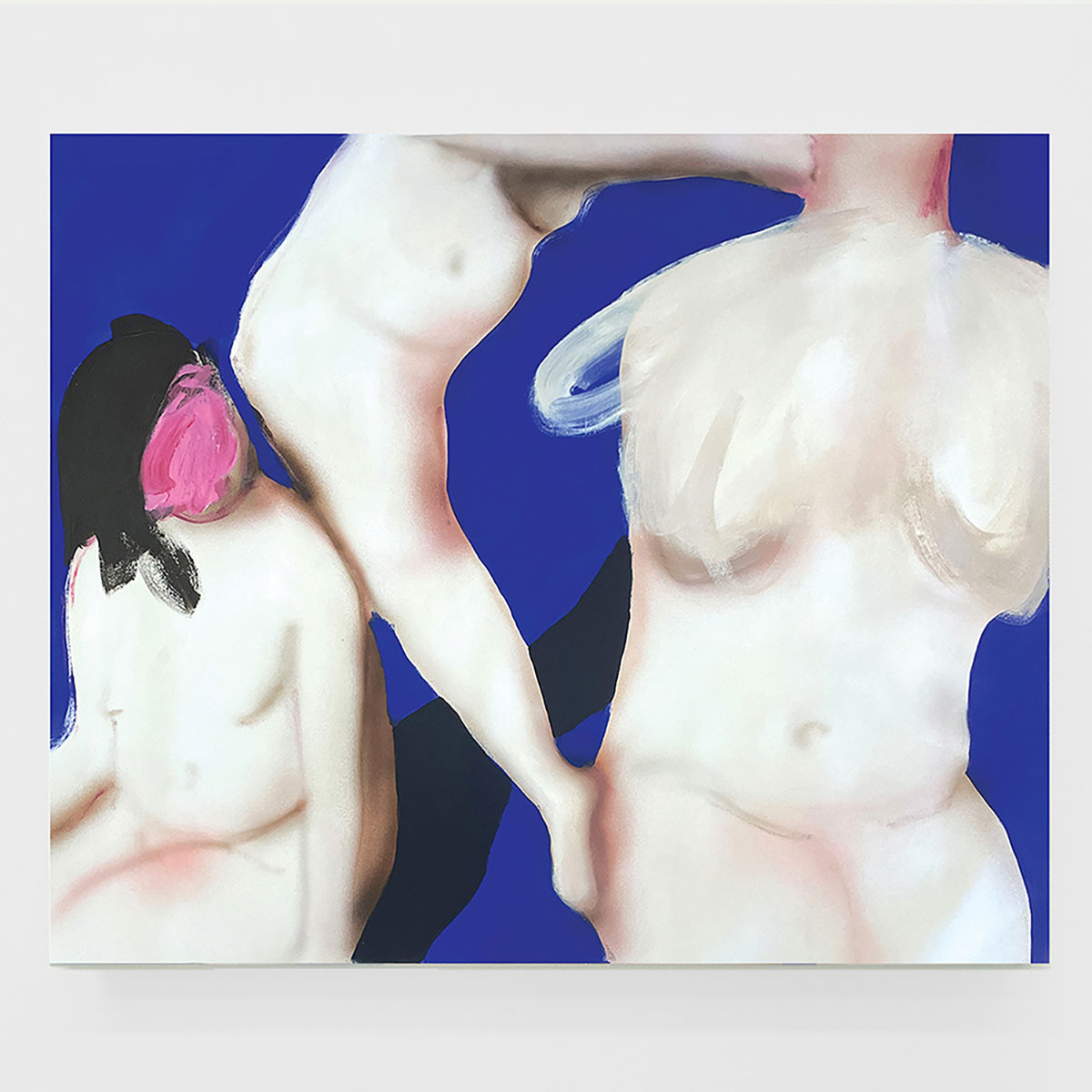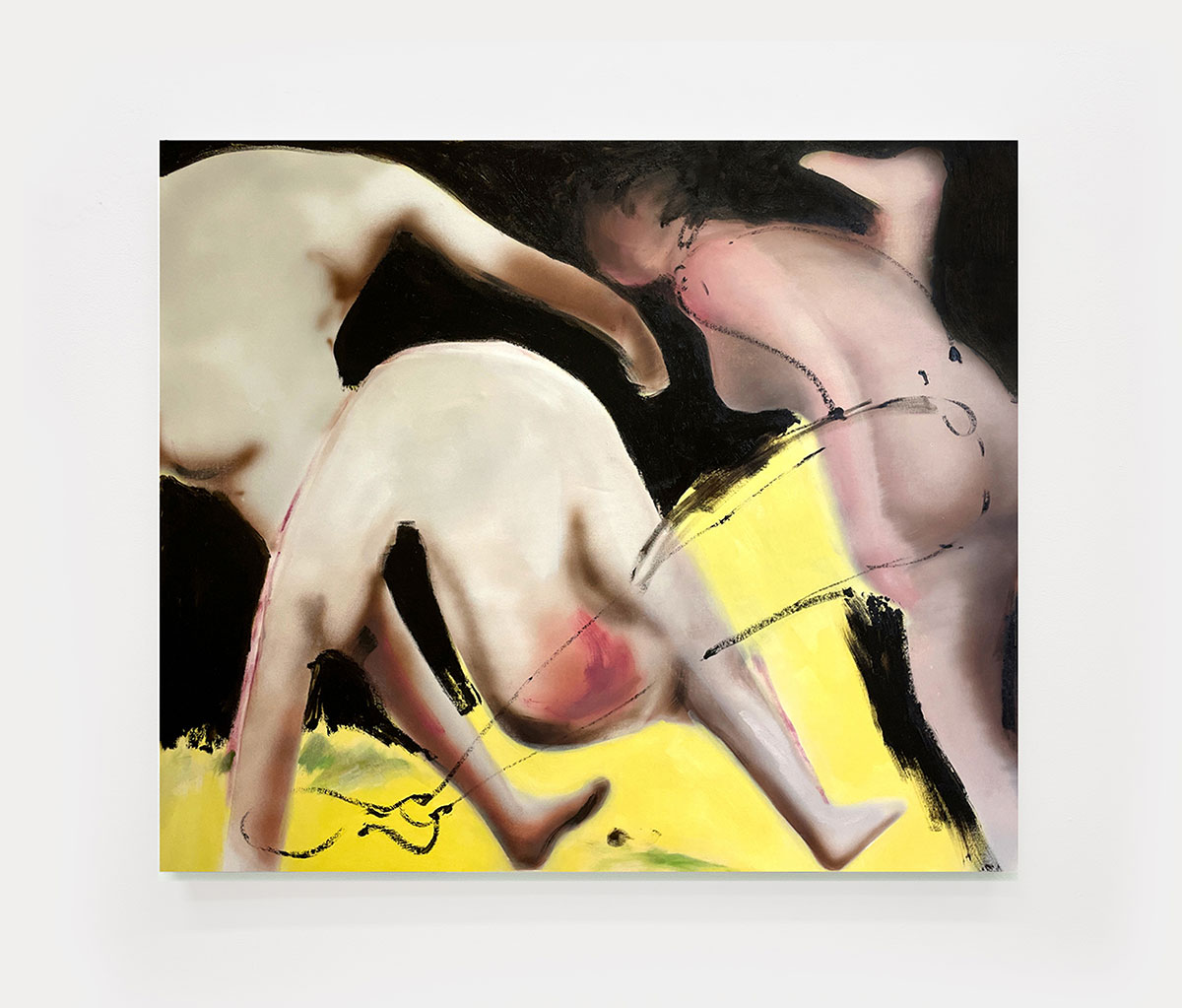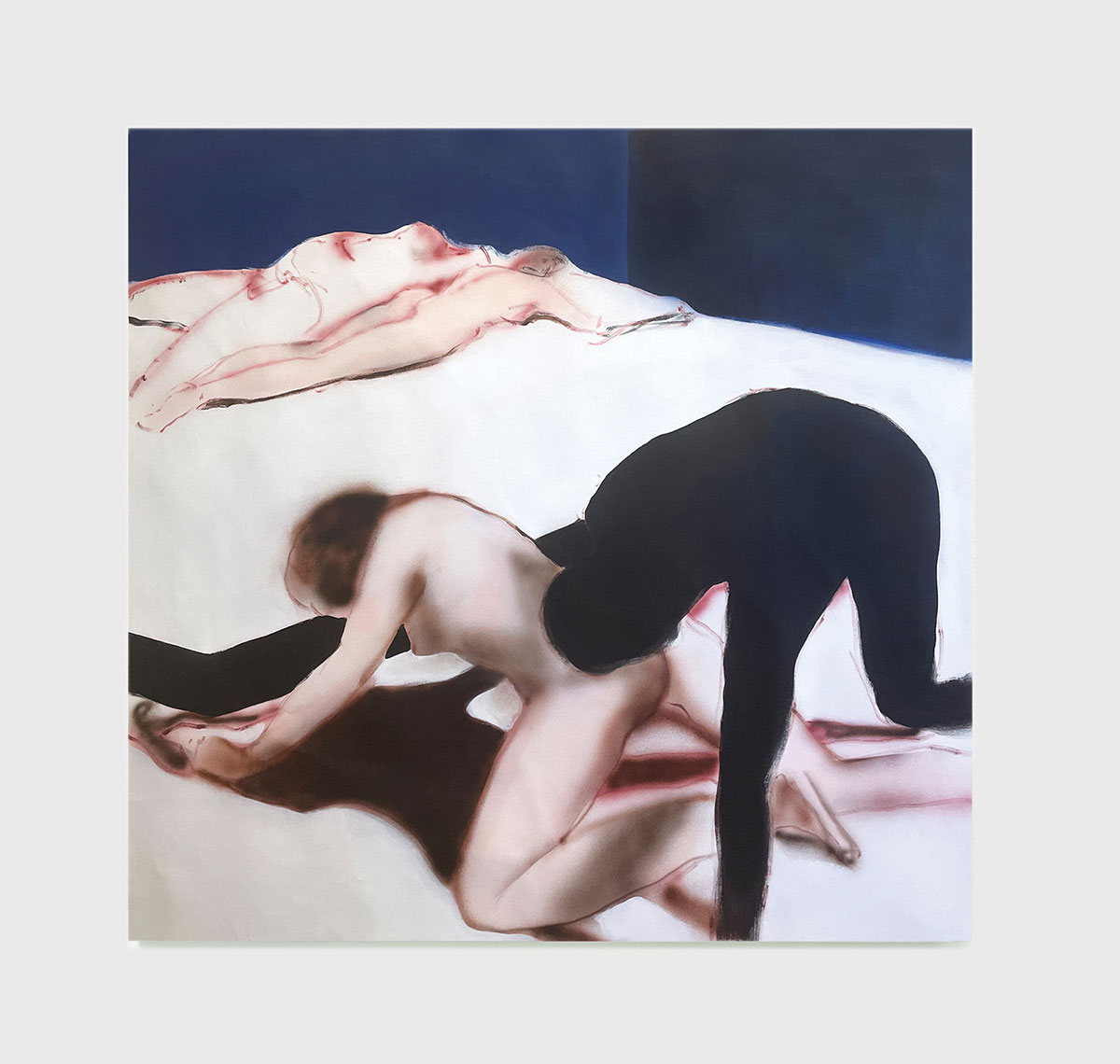Gallery: FUTURES Gallery
Exhibition: Sarah Drinan, Flesh Boundaries
When I arrive at FUTURES the gallery-sitter is eating a bowl of soup alone at the front desk. It is quiet and I feel awkward about interrupting lunch so I walk straight into the show. In Spring, the first of Sarah Drinan’s paintings I see on entry, three naked bodies glow at you. They are distinct yet paused in a moment of contact: a knee grazes a shoulder, a foot touches a hip, one’s arm dissolves into another’s neck. The figures float against a backdrop of blue. This blue, so rich and melodic that it must have its own name. A shadow, a recurring feature across the exhibition, drifts across the canvas from beneath the only figure whose head is in the frame.The figure’s hair is black and their face is an anonymous pink blur. Each figure addresses one another in a triangular way. I am beside them, present as a viewer but not a participant in the exchange. The sitter sidles in to give me a room sheet and a copy of the exhibition text while I am staring at this painting. We nod at each other warmly and then she leaves to (presumably) finish her soup. I didn’t think much of this interaction or the soup at the time but upon reflection it seems like a nice parallel to Drinan’s paintings: transmissions of encounters-in-motion and intimacies both strange and ordinary.

Flesh Boundaries explores the body as a primary paradox. To feel is also always to be-felt, to touch is also always to be-touched. A paradox depends on indeterminacy: two “opposing” elements wobble nebulously in a kind of truthful incommensurability. A paradox confounds, like when trying to explain a dream or hold onto a moment of déjà vu. These things resist the order-making capacity of language. They occur at a borderland where the ambivalent semantic charge of ‘sense’ is lost and the word means only ‘to perceive, to feel’. The body, as Drinan writes, is ‘a metaphorical container, functioning as both a conduit and barrier between the inside and outside world’. It seems relevant to note that Drinan works as an occupational therapist alongside their art practice. This is work situated around the daily experiences that make up a life — how to access or ease their doing for bodies of varying ability — and so this paradox moves beyond the purely subjective. The body is understood as a condition, a container, that is always both conduit and barrier in many ways and forms. In Dance Battle a black line sketches the outline of an absent leg as if to say ‘this is how I would move’ or ‘this is how I am going to move’ or ‘this is how I did move’. I get the sense that the motion is real and happening, just not in the present tense. The leg splices through the two other figures in the painting, a presence that seems to throw them sideways even in fleshy absence.
Most of the time, feeling is messy. To bring the outside in: when I arrive at FUTURES, I am feeling messy. I am in the midst of a break-up and listening to a sad song that goes ‘I’m like an apple with no skin, turning brown’. Peel an apple of its skin and you take away the visual signifier one would generally use to distinguish it. What you are left with is texture and taste; the specific sensory experience of an apple. How better to communicate this than to share it? To chew together? With a break-up comes a similar and opposing question: what is mine and what is yours? How do we begin to untangle? I find this ambiguity in the gesture of the soft figures in Blue and Crushing. They glance back while turning away. They linger on the edge of relation. Of course this can be read (like the title suggests) as the shy and radiant moment of first contact between lovers. But both embrace and separation hinge on the existence of a boundary. It is the direction of the transgression that renders them different.
The above sentence is mine but the source of its sentiment is Anne Carson, whose essay Eros the Bittersweet is quoted in the exhibition text. Tracing through Ancient Greek poetics, Carson locates Eros as an experience of lack — ‘the interval between reach and grasp, between glance and counterglance, between ‘I love you’ and ‘I love you too’’1 — that alerts one to the boundary of the self and to the impossibility of complete rupture. Group Moment centres this present void: a shadow wraps and bends around a figure on all fours. The moment is charged, erotic. In the corner, another couple lie heavy and sleeping on a big mattress in a blue room. Though Carson’s idea of Eros aligns with the way that the bodies in Flesh Boundaries exist on this im/permeable edge, the temporal moment Drinan freezes them in hums with excess. In an instance of paradox I am reminded of Chris Kraus: ‘Love and sex both cause mutation, just like I think desire isn’t lack, it’s surplus energy – a claustrophobia inside your skin’.2 Sure, Eros satisfies but it also disappoints. We never reach rupture, we just keep feeling the urge for it, to be split like a body and its shadow.


Another synchronicity: when I arrive at FUTURES I have been reading through Carson’s back catalogue. Like Drinan, Carson has a way of taking an everyday thing and making it sensational. The figurative encroaches on scenes of ordinary encounter. In Autobiography of Red, two boys see each other for the first time at a train station. It is one of those moments of uncanny recognition: ‘they were two superior eels at the bottom of the tank and they recognized each other like italics’.3 I read this line maybe seven times over, wondering how something so random, so disjointed and abstract, could feel so totally true. In Beluga and Me a human figure and a beluga whale bob together in bright red, both their backs turned, caught in an unguarded exchange. Beluga’s face is captured in profile and paused in a moment of speech directed at ‘me’. It’s so strange that it’s familiar.
The work I am most taken by is Venus Falling on a Prick, which is also the last painting I look at. A headless nude hovers just above the ground, body lacking parts and confounding sensical anatomy, curved and falling backwards over a headless four-legged animal. Strokes of pink on the nude suggest blood or heat. It sounds violent but it is not. Both the animal and the human body have a shared grace to them. Perhaps, this is rupture. This painting sits resolute and alone at the end of a short corridor off the main room of FUTURES. The corridor bends around a corner into shadows. Moving toward it I have the sense I am walking forward into a memory.
1. Anne Carson, Eros the Bittersweet: An Essay, New Jersey: Princeton University Press, 1986, p. 30.2. Chris Kraus, I Love Dick, London: Serpent’s Tail, 2016, p. 239.3. Anne Carson, Autobiography of Red, New York: Knopf, 1998, p. 39.
Madison Pawle is a writer living on unceded Wurundjeri Country.
This text was commissioned through the Emerging Writers’ Program. An annual collaborative project, from KINGS and un Projects, that supports critical arts writing, fiction, poetry, experimental, cross-genre and digital text forms. The Emerging Writers’ Program provides professional publishing opportunities and fosters dialogue between artists and arts writers. Each emerging writer in the program receives critical feedback and editorial assistance from KINGS and un Projects personnel.
Supported by Creative Victoria, City of Melbourne and City of Yarra.
